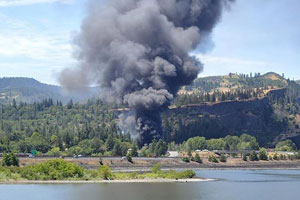Port of Vancouver's Rail Speeds Err on Side of Safety

“Even though we maintain above and beyond what the class is, we keep a lower speed limit,” said port rail manager Wayne Harner.
In light of last week’s oil train derailment and fire in Mosier, Oregon (photo at right), the port on June 8 talked about the state of its infrastructure and what it does to prevent and prepare for accidents.
When the West Vancouver Freight Access Project wraps up, the port will have 52 miles of track under its control. And every mile of that has a speed limit of 10 mph — though the port maintains the tracks as though the speed limit were 25 mph.
“The biggest thing when you have to think about any derailment, looking at Mosier, the biggest thing is speed,” Harner said. “Without that speed, the physics aren’t there to have that kind of impact.”
The port also has many concrete ties and welded track to prevent the kind of gauge-widening that reports say led to the Mosier derailment, the resulting black cloud of oil smoke that darkened the Columbia River Gorge sky and renewed calls for an end to oil-by-rail transport. Vancouver Energy’s proposed oil terminal at the port would see an average of four more oil trains per day heading through Vancouver on the Washington side of the Gorge.
Harner said the port has seen just four minor train car derailments since February 2015, each caused by operator error.
“Usually those occur when we’re just switching cars around,” Harner said. “At those speeds, I don’t think there were any wheels off the track beyond the top of the ties.”
The port has nine “maintenance of way” crew members whose primary job is rail maintenance, and has seven sheds spaced throughout its rail network full of accident-response equipment, ranging from booms to kiddie pools to fire extinguishers.
BNSF, which runs most of the mainline tracks in Washington state and those that border the Port of Vancouver, said it has invested $500 million in Washington state rail infrastructure in the past three years and $15 billion across the country.
“Our operation at Vancouver has never been stronger than it is today,” said Gus Melonas, a spokesman for BNSF. “There hasn’t been this level of maintenance, engineering activity and upgrades since the original construction of the rail yard.”
Melonas said an average of two oil trains run on the tracks through Vancouver per day, usually at speeds between 10 to 15 mph.
A recently released study commissioned by the city of Vancouver showed that a worst-case scenario oil train derailment could cost Vancouver up to $6 billion.
Port spokeswoman Abbi Russell said a study showed the BNSF/port rail border in downtown Vancouver has a low risk of derailment.
“We’ve advocated for rail safety with our local partners and state and federal legislators, supported legislation like the Crude-By-Rail Safety Act of 2015, and have improved our internal rail system to further support safe movement of cargo by rail,” she said in a statement following the Mosier accident.

